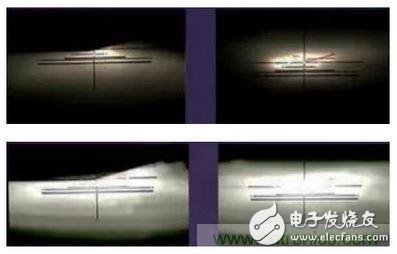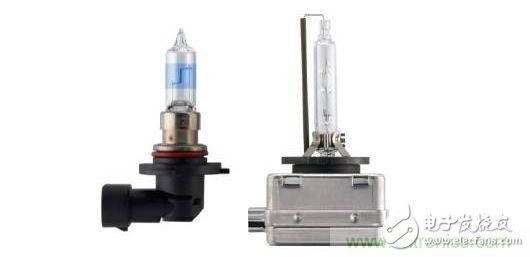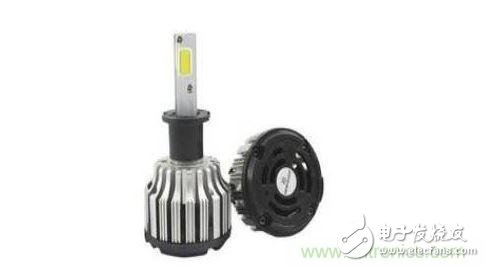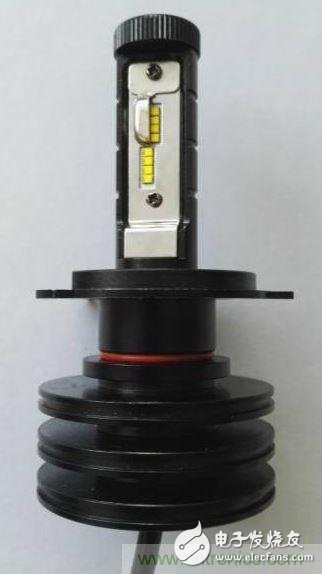Automotive headlamp bulbs made of LEDs have significant advantages such as long life, high brightness, and long projection distance. They have become the preferred source for large-area replacement of halogen and xenon lamps, and adaptive vehicles made of multi-beam smart glare LEDs. The headlights have also become the trend of the next generation of headlights for automobiles.
As can be seen from Figure 1, from the perspective of road lighting, the headlights of the car with LEDs are obviously superior to the headlights of the car using halogen lamps in terms of vision, brightness and projection distance. The life of the former is several dozens of the latter. Times.

Figure 1: The above picture shows the near (left) far (right) light effect of the car headlights with halogen lamps. The following figure shows the near (left) far (right) light effect of the car headlights with LEDs.
Although LEDs are a new kind of illumination source, in terms of auto parts and aftermarket, because the original lamp body system of the car headlights must be used, the dimensions and fixing methods of the LEDs headlight bulbs are designed. Interfaces, power and control, illuminating area shape, brightness and luminous flux should be as consistent as possible with halogen bulbs and xenon bulbs.
When replacing halogen bulbs and xenon bulbs, there is no need to make major changes to the lamp body. As a new alternative light source, automotive headlamps using LEDs must provide users with a new experience, not only in terms of longevity and reliability, but also without increasing or even reducing glare. Increase ground illumination and throw distance.

Figure 2: Halogen bulb (left) and xenon bulb (right)
As can be seen from Figure 2, both the halogen bulb and the xenon bulb are linear light sources, and the bright area is about 4-6 mm in length and 1-1.2 mm in diameter. It is ideal as an LED headlight bulb for replacing halogen bulbs and xenon bulbs. The illuminating area should be 4-6mm x 1.1-1.2mm. Obviously, LEDs with linear illumination areas are the preferred source of LED headlight bulbs for LEDs.
As a mature light source, LEDs have been widely used in lighting, backlight, display and other fields. The glare LEDs are characterized by small size, high current and high reliability. They are mainly used in directional projection lighting, such as automobile headlights and motorcycles. Lamps, pico projectors, stage lighting, portable glare lighting, ultra long distance searchlights, etc. At present, the glare LED package forms for automotive headlights and motorcycle lamps are COBs (short for chip on board), CSP (short for chip scale package)-COBs, 2016-LEDs or CSP-LEDs, high-power ceramics. LED modules for LEDs and automotive headlights.

â–² Figure 3: Car headlight bulbs made with COBs
Figure 3 shows a car headlight bulb made of COBs. The luminous flux of such a light source can be very high, depending mainly on the size of the light-emitting area. Generally can reach 2000-3000LM. COBs are usually surface light sources and are not linear sources. Even if the light-emitting area of ​​the COBs is elongated into a strip shape, ceramics or superconducting aluminum with good thermal conductivity are used as the substrate, and the limitation of the package form is still unable to achieve the goal of small size, large current, high reliability. Car headlight bulbs made with COBs, because the shape of the light-emitting area is far from that of halogen bulbs and xenon bulbs, many light from the linear area becomes harmful stray light and glare, which cannot be improved. The effective illumination of the road surface also destroys the light shape and brightness distribution of the projected beam. Simply increasing the luminous flux not only brings more serious heat dissipation problems, but the severe glare and deformed light intensity distribution will become a safety hazard. Automotive headlamp bulbs made with COBs, although low in cost, have poor reliability and light shape and can only be primary products and have been eliminated by the mainstream market.
Figure 4: Automotive headlight bulbs made from high-power ceramic-based LEDs.
Figure 4 shows a car headlight bulb made from high-power ceramic-based LEDs. High-power ceramic-based LEDs are small-sized, high-current, high-reliability and bright-light LED light sources, mainly represented by CREE's XHP35, XHP50, XHP70, and XML-2. Because high-power ceramic-based LEDs have lenses with conventional LEDs and vertical chips that often use high-efficiency, their luminous efficiency is usually higher than other LEDs. The ceramic substrates used, due to their low thermal resistance, enable high-power ceramic-based LEDs to be used normally under over-driven conditions.
Due to the limitation of the package form, the chips in the high-power ceramic-based LEDs can only be arranged in a square shape, and the light-emitting area is rounded through the lens. Obviously, when high-power ceramic-based LEDs are installed in the whole headlight bulb, many light from the linear area becomes harmful stray light and glare, which not only can not improve the effective illumination of the road surface, but also It will destroy the light shape and brightness distribution of the projected beam. In addition, high-power ceramic-based LEDs are large in size due to the size of the substrate, and the mainstream products are 7070, 5050 and 3535. If two high-power ceramic-based LEDs are arranged tightly on a narrow car headlight circuit board in order to increase the luminous flux, dark areas will appear, and the luminous flux is wasted more, which is not worth the loss.
Although high-power ceramic-based LEDs have insurmountable shortcomings when used in automotive headlights, they are favored by the market due to their relatively mature package form and high luminous efficiency. At present, most of the LED headlight bulbs use high-power ceramic-based LEDs. The main domestic and foreign suppliers include American CREE, South Korea LG, Taiwan Weitian, and Jiangxi Jingrui. With the emergence of linear glare LED sources with better price/performance and user experience, such as the 2016-LEDs and CSP-COBs described below, the application of high-power ceramic-based LEDs to automotive headlights may be gradually replaced.

Figure 5: Automotive headlight bulbs made with 2016-LEDs.
Figure 5 shows the automotive headlamp bulbs made with 2016-LEDs, which are characterized by linearly arranging LEDs with a size of 2mm x 1.6mm on the panel of the headlights of the car. At present, Philips Lumileds' LUXEON Z and ZES are mainly used. The original design of the 2016-LEDs is for flash lamps and is a small-sized, high-current, high-reliability and high-light LED light source. In order to ensure sufficient light efficiency under high power usage conditions, good thermal conductivity and control of the illumination angle within 120°, 2016-LEDs often use large-size flip-chip, vertical or thin film flip chip plus ceramic substrate packaging technology. Its manufacturing cost and use cost are relatively high. Currently, 2016-LEDs are mainly used to manufacture high-end LED car headlight bulbs. The main suppliers of 2016-LEDs are Philips Lumileds of the United States, Samsung of South Korea, Taiwan Everlight, Shenzhen Avenue Semiconductor, Guangzhou Hongli, Guangzhou Jingke, and Jiangxi Jingneng.
CSP-LEDs featuring small sizes are also applied to LED headlights. At present, there are many types of CSP-LEDs, and the production process and technology are also very different. At present, CSP-LEDs are mainly based on five-sided illumination. Because the fluorescent layer on the CSP-LEDs is three-dimensionally wrapped around the flip chip, the adhesion is relatively poor. During the die bonding and reflow process, any mechanical collision, difference in tin melting and thermal expansion coefficient will lead to the fluorescent layer. The flip chip is detached and fails.
Obviously, compared to 2016-LEDs, CSP-LEDs are not well suited for making highly reliable automotive headlamps. At present, the main suppliers of CSP-LEDs at home and abroad include South Korea's Samsung and Seoul, Taiwan's Jingdian, Shenzhen Dongpuguang, and Zhongshan Stereo Photoelectric.
![The car headlights made of high-power LEDs shown in Figure 4 were modified with CSP-COBs manufactured by Shenzhen Avenue Semiconductor. [Photographed from modified purchased products]](http://i.bosscdn.com/blog/01/53/11/4a1_0.jpg)
Figure 6: CSP-COBs manufactured by Shenzhen Avenue Semiconductor. Modified car headlights made of high-power LEDs as shown in Figure 4.
Figure 6 shows a car headlight bulb made with CSP-COBs. CSP-COBs is a linear arrangement of flip-chips on the surface of an aluminum nitride ceramic substrate, and then the fluorescent glue is three-dimensionally wrapped around the flip chip by spraying, and its shape and patch are on the surface of the circuit board. CSP-LEDs are similar, so they can be called CSP-COBs.
In CSP-COBs, the perfect combination of flip-chip and aluminum nitride ceramic substrates allows CSP-COBs to have the lowest thermal resistance and allow for high current densities. The light-emitting areas formed on the CSP-COBs by the linearly arranged flip-chips not only do not produce dark areas, the center brightness is high, and the center illumination on the illuminated surface is also high. After loading the headlights of the car, the utilization of the luminous flux is high because there is no waste of stray light. In general, the central illumination of a car headlight with a CSP-COBs with a luminous flux of only 1200-1500 LM as a light source can achieve the central illumination of a car headlight with high-power ceramic-based LEDs with a luminous flux exceeding 2000 LM as a light source, reducing heat. More than 20%.
In addition, CSP-COBs typically have a substrate size of 5mm x 5mm or 7mm x 7mm and have electrode pads and thermal pads on the back that are identical in size to CREE XHP50 and XHP70. When used, the 5050 and 7070 CSP-COBs can directly replace the CREEXHP50 and XHP70, respectively, without changing the original board and lamp body design. Because the heat-dissipating pad on the back of the CSP-COBs has a large area, even if the CSP-COBs are soldered to the automotive headlamp circuit board made of a conventional copper-clad metal substrate, the problem of the board burning will not occur and the reliability is high.
There are no molded lenses on the surface of CSP-COBs, which makes the light shape closer to halogen lamps and xenon lamps, and the projected light shape is more similar to the light intensity distribution. Because there is no molded lens protection, the fluorescent layer wrapped on the surface of the flip chip is more susceptible to loss than the lens, and some products are easy to fall off, so that the yield of CSP-COBs at the time of solid crystal reflow is relatively low. Care should also be taken when installing the lamp to avoid touching the surface of the illuminated area of ​​the CSP-COBs.
At present, the main suppliers of CSP-COBs are Shenzhen Fulunde, Guangzhou Tianxin, Shenzhen Avenue Semiconductor, Dalian Dehao Runda and so on. The adhesive layer of CSP-COBs produced by Shenzhen Avenue Semiconductor is relatively strong and not easy to be damaged. The illumination angle is relatively small 3-5°, which makes the center illumination at the same luminous flux higher. Based on the 5050 and 7070, the market recently introduced products such as 3570 and 1860.
Reducing the substrate size can reduce the manufacturing cost of CSP-COBs, but it does not improve the performance and user experience of automotive headlamps. The reduced size not only requires changing the board design, but more importantly, as the area of ​​the heat sink is halved, the thermal resistance doubles, affecting the conduction efficiency of the heat in the light-emitting area to the heat sink. When the substrate size is close to the chip size, since the fluorescent rubber coating layer is very close to the edge of the substrate, the adhesion fastness and the anti-vulcanization ability are affected. Obviously, the use of too small a substrate size for CSP-COBs will be detrimental to thermal conductivity and product reliability.

Figure 7 shows OSRAM and Philips' automotive headlamp-specific LED modules, which are mainly used in the front-loading market and in the auto-distribution and after-loading market for automotive headlights designed for automotive headlamp-specific LED modules. The main suppliers are Germany OSRAM, USA Philips Lumileds, South Korea LG, Japan Nichia, etc. Among them, OSRAM and LG use UX3 vertical chip, Philips Lumileds use TFFC film
Flip chip and Nichia use new technologies such as flip chip and dam and fluorescent glass. At present, the traditional dressing, flip-chip and vertical chips used by domestic and Taiwanese companies cannot meet the demanding requirements of optical modules, illuminating angles, thermal conductivity and reliability of automotive headlamp-specific LED modules.
From the above simple analysis, we can see that in the auto parts and aftermarket, it still replaces traditional halogen bulbs and xenon bulbs. Automotive headlamp bulbs made with glare LEDs should be as consistent as possible with halogen bulbs and xenon bulbs in terms of form factor, mounting and interface, power and control, shape of the illuminating area, brightness and luminous flux. The use of traditional COBs, although low in manufacturing cost, is relatively poor in reliability and light shape, and has been eliminated by the mainstream market.
Due to the insurmountable shortcomings and high cost, the application of high-power ceramic-based LEDs in automotive headlights will be gradually replaced by linear glare LEDs with better cost performance and user experience. Linear glare LEDs can be placed in a linear array of 2016-LEDs on the board, or 5050 and 7070 CSP-COBs. Five-sided illuminated CSP-LEDs are not suitable for making highly reliable automotive headlights. The LED module for automotive headlights is mainly used in the front-loading market and in the auto-distribution and after-loading market of automobile headlights designed with LED modules for automotive headlights.
Ring Common Mode Inductor,UU Common Mode Inductor,Vertical Plug-in Common Mode Inductor,Power Line Common Mode Choke
Xuzhou Jiuli Electronics Co., Ltd , https://www.xzjlelectronic.com